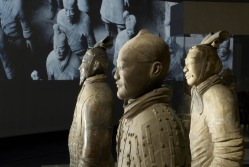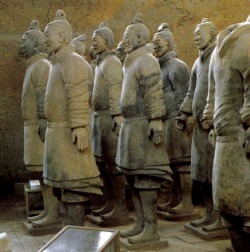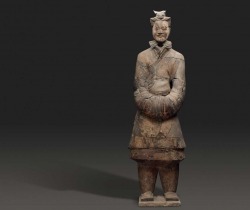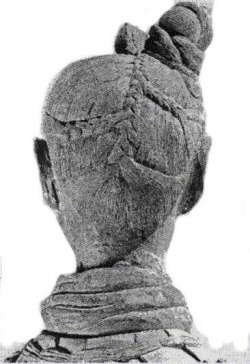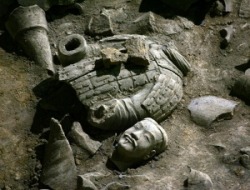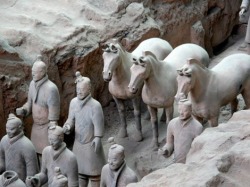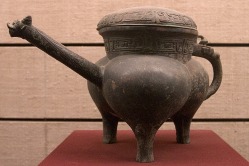The Terracotta Army
The Terracotta Army was commissioned by the Emperor after he took over. Work on the mausoleum started in 247 BCE, and it is said that the construction took 38 years to complete. The purpose of the terracotta army was to help the Emperor rule in the afterlife. They also represent the emperor's ability to conrol the resources of unified China, and an attempt to recreate and maintain the empire in the afterlife.
The Terracotta Army has become known as the eighth wonder of the world. They give of the illusion of strength and manpower. It was said that when enemies approached the emperor's tomb, they would become overwhelmed by the powerful army supporting Emperor Qin and turn away.
The soliders range between 5 foot 8 inches and 6 foot 2 inches. The lower half of the bodies were made of soild terracotta clay, and the top half were hollow. The statues were vivdly painted with a coating of lacquer mixed with colors. Each individual statue had unique facial features and expressions.
The soliders ranks were shown through varying uniforms and hairstyles. It is also believed that certain hairstyles may ward off evil, so a lot of attention was placed on this feature.
Shortly after the end of the Qin Dynasty, a fire was set to the wooden supports in the pits where the terracotta army was held. The figures were broken during the fall, but since the figures have been discovered where they landed reconstruction has been proven to be possible.
In 1974, excavation efforts began after 1,000 pieces of pottery figurines were found when Chinese workers were digging a well. Three pits have been discovered, and it is believed that even more exist. In one pit alone more than 6,000 statues were found, all standing in battle formation.
Due to the fasination with the terracotta warriors many museums have begun to have exhibits about the massive warriors. Such museums include The Metropolitian Museum of Art, The British Museum in London, the Houston Museum of Natural Science, and the National Geographic Museum in Washington, D.C.
Due to the fasination with the terracotta warriors many museums have begun to have exhibits about the massive warriors. Such museums include The Metropolitian Museum of Art, The British Museum in London, the Houston Museum of Natural Science, and the National Geographic Museum in Washington, D.C.
Pottery
Though the Qin Dynasty is mostly known for the terracotta army, they also made great strides in pottery. Two pieces are pictured above. Pottery was used daily for cooking and even dining utensils. They were made from hard clay that was either gray, red, or black. And besides being used for daily tasks, some of the pottery was made as funeral pieces. The pottery was also seen as a rarity because it could only be found in certain parts of the dynasty.
Calligraphy
Along with pottery and the terracotta army, the Qin Dynasty created a new style of calligraphy. Calligraphy may have been used in work situations, but it was also seen as an artform that developed throughout the Qin Dynasty.
In 221 B.C., several wars enabled the Qin rulers to take over China and rule it as one state. In doing this they needed uniformity, which was in part created by a writing system reform. They created the small seal script which is one of the most enduring of all ancient scripts. It was based upon may regional variations and contained nearly 12,000 characters. Also, it simplified the big seal script by reducing the stroke number and fixing the character component placement. The characters were all the same size and thickness making it regular.
Clerical script also became common due to the rise in clerical work. It was a simplification of seal script because it made up new character components and stretched the pictographic winding strokes straight. And after the Qin Dynasty the clerical script fully developed in the Han dynasty.
In 221 B.C., several wars enabled the Qin rulers to take over China and rule it as one state. In doing this they needed uniformity, which was in part created by a writing system reform. They created the small seal script which is one of the most enduring of all ancient scripts. It was based upon may regional variations and contained nearly 12,000 characters. Also, it simplified the big seal script by reducing the stroke number and fixing the character component placement. The characters were all the same size and thickness making it regular.
Clerical script also became common due to the rise in clerical work. It was a simplification of seal script because it made up new character components and stretched the pictographic winding strokes straight. And after the Qin Dynasty the clerical script fully developed in the Han dynasty.
